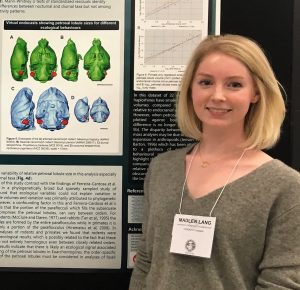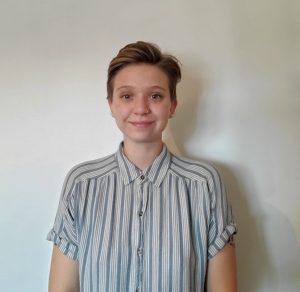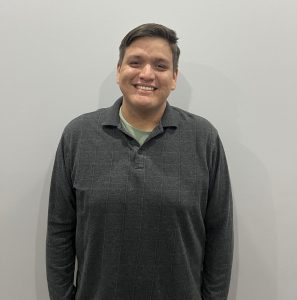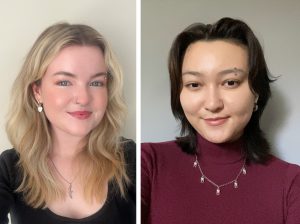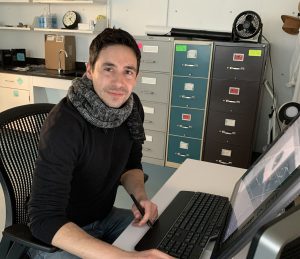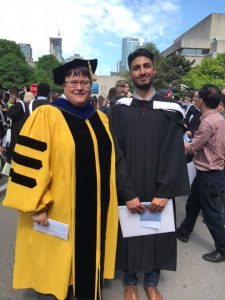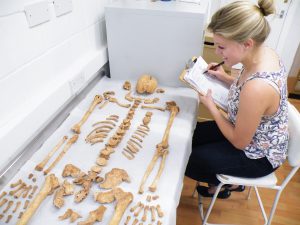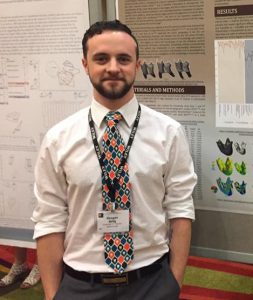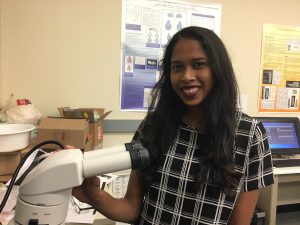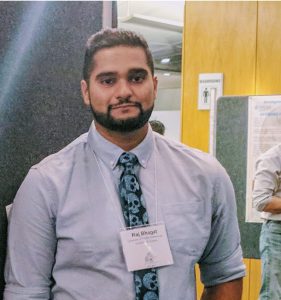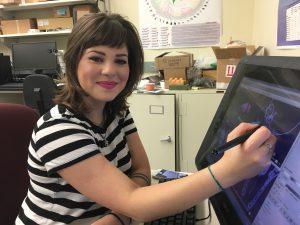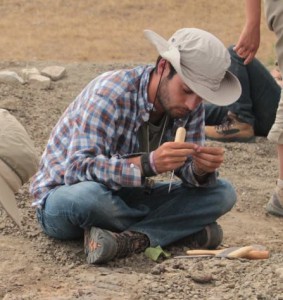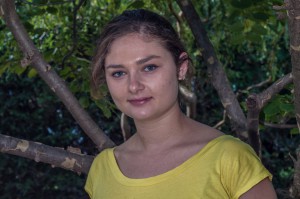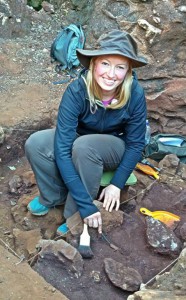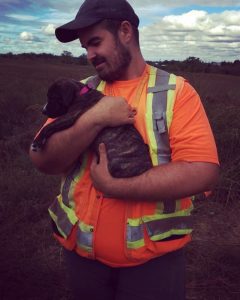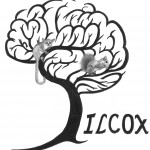Graduate Students
Madlen Lang, MSc, PhD student
I am particularly interested in the evolution of the primate brain and their sensory systems. My research focuses on the scaling trends of the petrosal lobules (structures of the brain associated with visual image stabilization) in living primates, dermopterans, scandentians, rodents, and lagomorphs. My goal is to determine if ecological factors such as diet, locomotor behaviour, and activity pattern play a role in the size of these structures. This research provides a unique opportunity to better understand the brain morphology of early primates.
Publications:
- Bertrand, O. C., Amador‐Mughal, F., Lang, M. M., & Silcox, M. T. (2018). Virtual endocasts of fossil Sciuroidea: brain size reduction in the evolution of fossoriality. Palaeontology, 61(6), 919-948.
- Bertrand, O. C., Amador-Mughal, F., Lang, M. M., & Silcox, M. T. (2019). New virtual endocasts of Eocene Ischyromyidae and their relevance in evaluating neurological changes occurring through time in Rodentia. Journal of Mammalian Evolution, 26, 345-371.
Presentations and Published Abstracts:
- Lang, M. M., Bertrand, O.C., Silcox, M.T. 2018. Scaling Pattern of Euarchontoglires Cerebellar Petrosal Lobules: Impacts of Locomotion and Activity Pattern. Society of Vertebrate Paleontology 2018 Program and Abstracts: 164.
- Lang, M. M., Bertrand, O.C., Silcox, M.T. 2018. Scaling patterns of primate paraflocculi: effects of phylogeny and ecology. American Journal of Physical Anthropology Program and Abstracts: 186-187. Poster Presentation at the 2018 American Association of Physical Anthropologists Meeting, Austin, TX.
- Lavania, N., San Martin Flores, G.A., Atell, M.G.I., Bertrand, O.B., Bhagat, R., Lang, M.M., López-torres, S., Selig K.R., Ward D.L, Viola, B., Silcox, M.T. 2018. New perspectives on cranial form in Euarchontoglires: A geometric morphometric study of primates and their kin. American Association of Physical Anthropologists: 186.
- Lang, M.M., Bertrand, O.C., and Silcox, M.T. 2017. Scaling pattern in rodent paraflocculi: impacts of locomotion and activity pattern. Society of Vertebrate Paleontology: 147.
- O.C Bertrand, O.C., F. Amador-Mughal, M. M. Lang, M.T. Silcox. 2017. Virtual endocasts of early Aplodontoidea and Sciuridae: brain evolution and locomotion. Society of Vertebrate Paleontology 2017 Program and Abstracts: 80-81.
- Lang, M. M. and Atell, M. I. Biological Anthropology and the Media: Lessons from Recent Controversies in a Changing Media Landscape. Podium Presentation at the 2017 MEDUSA Anthropology Graduate Student Union Conference, Toronto ON.
______________________________________________________________________________________________________________
Mads Rose, MSc, PhD Student
My PhD research is centered around exploring how the microstructure of bones can be used to predict how a fossil species moved during life. Using cranially associated fossil remains, I will be using cutting edge MicroCT technologies to visualize the trabeculae in every long bone of my focal species. Then, I plan to contextualize these data using the long bones of extant primates and related taxa. Finally, I will reconstruct how my focal species locomoted during life, revealing novel data on a critically informative plesiadapiform species.
Publications:
- Rose, M., Tawane, M., Kivell, T., In Press. Taxonomic and functional interpretation of associated cercopithecoid carpal bones (KB 5378) from Kromdraai B, South Africa. Paleoanthropology.
- Dickinson, E., Tomblin, E., Rose, M., Tate, Z., Gottimukkula, M., Granatosky, M. C., … & Hartstone‐Rose, A. (2023). Ecomorphological correlates of inner and middle ear anatomy within phyllostomid bats. The Anatomical Record.
- Dickinson, E., Boettcher, M. L., Smith, M. R., Worden, N. A., Swindell, S. R., Seelye, J. S., … & Hartstone‐Rose, A. (2021). Myological variation in the forearm anatomy of Callitrichidae and Lemuridae. Journal of Anatomy, 239(3), 669-681.
- Duke, E., Harrison, S.H., Moresco, A., Trout, T., Troan, B., Garner, M., M.R., Smith, Smith, S. and Harrison, T.M., (2022)“A Multi-Institutional Collaboration to Understand Neoplasia Treatment and Survival of Snakes,” Animals, 12(3), 258.
Presentations and Published Abstracts
- 89th Annual Meeting of American Association of Physical Anthropologists. Presented abstract, “Qualitative and quantitative variation within the antebrachial musculature of Callitrichidae and Lemuridae”. Accepted for Presentation 2020.
- Littwack Conference: Presented data on investigations of neoplasia and therapeutic intervention in snakes. Presented 2018.
- Duke Consortium for Canine Comparative Oncology: Presented data on efficacy of utilizing the ESCRA database for the consolidation and distribution of cancer treatment data of exotic species. Presented 2018.
_____________________________________________________________________________________
Griffin Assance-Goulais, MSc Student
Hi, I’m Griffin. I am a second-year MSc student under the co-supervision of Dr. Mary Silcox and Dr. David Begun. I specialize in the endocranial morphology of fossil primates, primarily in fossil hominids from the mid-to-late Miocene. Currently, using CT data, I am working to reconstruct and describe a partial endocast of the Hungarian fossil ape, Rudapithecus hungaricus, to better understand the evolution of brain morphology in the great ape lineage. I also have research interests outside of fossil apes, as some of my ongoing projects involve materials from extant taxa ranging from great apes to cercopithecoids.
_____________________________________________________________________________________
Postdoctoral Fellow
Camilo López Aguirre, PhD
I study the eco-evolutionary dynamics linked to the phenotypic diversification of tetrapods. My research has mainly focused on the morphological evolution of mammals, both living and extinct, with a particular interest in bats. Combining palaeontological, embryological, and comparative anatomical studies, my work implements multiple statistical and computational techniques to assess the developmental, ecological and biological drivers of tetrapod evolution. I also apply my quantitative analytical skills to assess the socioeconomic factors influencing the scientific endavour, particularly in my native Colombia, to inform the debate around how to truly democratise science.
Publications:
- López-Aguirre, C. Hand, S. J. Simmons, N. B. Silcox, M. T. (2022) Untangling the ecological signal in the dental morphology in the bat superfamily Noctilionoidea. Journal of Mammalian Evolution 29: 531-545. https://rdcu.be/c8R4k
- Nojiri*, T. Wilson*, L. A. B. López-Aguirre*, C. et al. (2021) Embryonic evidence uncovers convergent origins of laryngeal echolocation in bats. Current Biology 31(7): 1353-1365. *These authors contributed equally to the study https://doi.org/10.1016/j.cub.2020.12.043
- López-Aguirre, C., & Farías, D. (2022). The mirage of scientific productivity and how women are left behind: the Colombian case. Tapuya: Latin American Science, Technology and Society, 5(1), 2037819.
_____________________________________________________________________________________
Research Assistant
______________________________________________________________________________________________________________
Undergraduate Work Study Students and Volunteers
Work Study Students: Erin Anderson & Dana Gawlak
______________________________________________________________________________________________________________
Lab Alumni
Undergrads: Annie Billings, Ashvika Baskaran, Nadia Lofaro Farrah Amador Mughal, Samantha Gionfriddo, Shallu Prasher, Rose Pidgeon, Derrick Lin, Sophia Li, Arvin Persaud, Jamila Norman, Rohail Ahmad.
Lab Assistant: Shayda Spakowski
______________________________________________________________________________________________________________
Rémi Allemand, PhD
Since leaving his post doctoral position with the Silcox Lab, Dr.Rémi Allemand is currently completing a subsequent post doctoral fellowship with the Museum National d’Histoire Naturelle, Sorbonne Universites, Paris, France studying the endocasts of extant squamates.
Publications:
- Allemand, R., Abdul‐Sater, J., Macrì, S., Di‐Poï, N., Daghfous, G., & Silcox, M. T. (2023). Endocast, brain, and bones: Correspondences and spatial relationships in squamates. The Anatomical Record, 306(10), 2443-2465.
- Allemand, R., Houssaye, A., Bardet, N., & Vincent, P. (2019). Endocranial anatomy of plesiosaurians (Reptilia, Plesiosauria) from the Late Cretaceous (Turonian) of Goulmima (southern Morocco). Journal of Vertebrate Paleontology, 39(2), e1595636.
- Allemand, R., Bardet, N., Houssaye, A., & Vincent, P. (2018). New plesiosaurian specimens (reptilia, plesiosauria) from the upper cretaceous (turonian) of Goulmima (southern Morocco). Cretaceous Research, 82, 83-98.
______________________________________________________________________________________________________________
Waqqas Khalid, MSc student
Title of Masters Research Paper: ” Dental Topographic Analysis of Mixodectidae”
______________________________________________________________________________________________________________
Devin Ward, MPhil, PhD
Dr. Devin Ward now works as both a professional archaeologist, and a senior editor for Nature Communications.
Publications:
- Ward, D. L., Pomeroy, E., Schroeder, L., Viola, T. B., Silcox, M. T., & Stock, J. T. (2020). Can bony labyrinth dimensions predict biological sex in archaeological samples?. Journal of Archaeological Science: Reports, 31, 102354.
- Baab, K. L., Copes, L. E., Ward, D. L., Wells, N., & Grine, F. E. (2018). Using modern human cortical bone distribution to test the systemic robusticity hypothesis. Journal of Human Evolution, 119, 64-82.
- Pomeroy, E., Grant, J., Ward, D., Benady, S., Reinoso Del Rio, M. C., Gutierrez Lopez, J. M., … & Lane, K. (2018). Death in the sun: the bioarchaeology of an early post-medieval hospital in Gibraltar. Post-Medieval Archaeology, 52(2), 239-255.
______________________________________________________________________________________________________________
Keegan Selig, MA, PhD
Following graduating with his PhD, Dr. Keegan Selig went on to complete a post doctoral fellowship at the Richard Gilder Graduate School of the American Museum of Natural History, and is now an assistant research professor at Duke University.
Publications:
- Selig, K. R., Sargis, E. J., & Silcox, M. T. (2019). The frugivorous insectivores? Functional morphological analysis of molar topography for inferring diet in extant treeshrews (Scandentia). Journal of Mammalogy, 100(6), 1901-1917.
- Selig, K. R., López-Torres, S., Hartstone-Rose, A., Nash, L. T., Burrows, A. M., & Silcox, M. T. (2019). A novel method for assessing enamel thickness distribution in the anterior dentition as a signal for gouging and other extractive foraging behaviors in gummivorous mammals. Folia Primatologica, 91(4), 365-384..
- Selig, K. R., Sargis, E. J., & Silcox, M. T. (2019). Three‐dimensional geometric morphometric analysis of treeshrew (Scandentia) lower molars: Insight into dental variation and systematics. The Anatomical Record, 302(7), 1154-1168.
______________________________________________________________________________________________________________
Lavania Nagendran, MSc
Since graduating with her Masters, Lavania Nagendran is now a PhD student with the Schroeder lab at the University of Toronto studying genetic hybridization in ancient human populations using coyotes as a modern comparative taxon.
Publications:
- Li, M. F., Nagendran, L., Schroeder, L., & Samson, D. R. (2022). The activity patterns of nonworking and working sled dogs. Scientific Reports, 12(1), 7999.
- Zdjelar, N., Nagendran, L., Kendall, C., Ackermann, R. R., & Schroeder, L. (2021). The hybrid skull of the eastern coyote (Canis latrans var.): Nonmetric traits and craniomandibular shape. Journal of morphology, 282(12), 1745-1764.
- Nagendran, L., Rose, K.D., Chew, A.E., Bown, T., Silcox, M.T. Unusual vertebrate assemblage from the McNeil Quarry of the Bighorn Basin, Wyoming (Willwood Formation, early Eocene, Wasatchian Nalma). Society of Vertebrate Paleontology 2018 Program and Abstracts: 188.
______________________________________________________________________________________________________________
Raj Bhagat, MSc
Since graduating with his Masters, Raj Bhagat has most recently left academia to pursue a career as an examinations specialist for the Chartered Professional Accountants of Ontario.
Presentations and Published Abstracts:
- Bhagat, R. and Silcox, M.T. 2018. Evolution of early euprimate locomotor agility and hearing sensitivity: insights from the inner ear of Cantius sp. (Bighorn Basin, Wyoming, Early Eocene, Wasatchian NALMA). Society of Vertebrate Paleontology, Albuquerque, NM, USA..
- Bhagat, R., Bertrand O.C., and Silcox, M.T. 2017. Locomotor behaviour reconstruction from the semicircular canals of early fossil rodents: insights into major evolutionary transitions from the inner ear. Society of Vertebrate Paleontology, Calgary, AB, Canada: 81.
- Bhagat, R., Bertrand O.C., and Silcox, M.T. 2017. Semicircular canal measurements and their use in reconstructing locomotor behaviour of fossil rodents. Animal Behavior Society, Toronto ON, Canada: 29.
______________________________________________________________________________________________________________
Gabriela San Martin Flores, MSc
Since graduating with her Masters, Gabriela San Martin Flores now works as a private teacher and science educator working with students of all abilities and ages.
Presentations and Published Abstracts:
- Nagendran, L., San Martin Flores, G.A., Atell, M.G.I., Bertrand, O.C., Bhagat, R., Lang, M.M., López-torres, S., Selig K.R., Ward D.L, Viola, B., Silcox, M.T. New perspectives on cranial form in Euarchontoglires: A geometric morphometric study of primates and their kin. American Journal of Physical Anthropology Program and Abstracts: 152.
- San Martin Flores, G.A., Nagendran, L., Bertrand, O. C., Silcox, M.T. Geometric Morphometrics on treeshrew cranial endocasts: a comparative analysis of scandentian and plesiadapiform brain shapes. Society of Vertebrate Paleontology. Society of Vertebrate Paleontology 2018 Program and Abstracts: 209.
- San Martin Flores, G., Nagendran, L., and Silcox, M. 2018. Insights into the primitive brain of primates: Treeshrew cranial endocasts and geometric morphometrics analysis. American Journal of Physical Anthropology Program and Abstracts: 165.
______________________________________________________________________________________________________________
Ornella Bertrand, PhD
Since graduating with her PhD, Dr. Ornella Bertrand moved on to complete multiple post doctoral fellowships at the University of Edinburgh, UK, and is currently a post doctoral fellow at the Institut Català de Paleontologia, Spain, studying brain evolution in gliding mammals.
Peer-reviewed publications:
- Bhagat, R., Bertrand, O. C., & Silcox, M. T. (2021). Evolution of arboreality and fossoriality in squirrels and aplodontid rodents: Insights from the semicircular canals of fossil rodents. Journal of Anatomy, 238(1), 96-112.
- Bertrand, O. C., Shelley, S. L., Wible, J. R., Williamson, T. E., Holbrook, L. T., Chester, S. G., … & Brusatte, S. L. (2020). Virtual endocranial and inner ear endocasts of the Paleocene ‘condylarth’Chriacus: new insight into the neurosensory system and evolution of early placental mammals. Journal of Anatomy, 236(1), 21-49.
- Bertrand, O. C., San Martin‐Flores, G., & Silcox, M. T. (2019). Endocranial shape variation in the squirrel‐related clade and their fossil relatives using 3D geometric morphometrics: contributions of locomotion and phylogeny to brain shape. Journal of Zoology, 308(3), 197-211.
______________________________________________________________________________________________________________
Sergi López-Torres, PhD
Since graduating with his PhD, Dr. Sergi López Torres completed a post doctoral fellowship with the American Museum of Natural History and is now an assistant professor at the University of Warsaw, Poland. His research focuses on mammalian evolution with a focus on the paleoecology and functional morphology of Euarchontoglires.
- Schillaci, M. A., Sutton, L. D., Wichmann, S., & López-Torres, S. (2021). Linguistic Clues to Kiowa-Tanoan Prehistory. Journal of the Southwest, 63(2), 255-368.
- López-Torres, S., & Silcox, M. T. (2020). What we know (and don’t know) about the fossil records of lorisids. Evolution, Ecology and Conservation of Lorises and Pottos. Cambridge university Press, Cambridge. https://doi. org/10.1017/9781108676526.005, 33-46.
- López-Torres, S., Selig, K. R., Burrows, A. M., Silcox, M. T., & Nekaris, K. A. I. (2020). The toothcomb of Karanisia clarki–was this species an exudate-feeder. Ecology and conservation of lorises and pottos. Cambridge University Press, Cambridge, 67-75.
______________________________________________________________________________________________________________
Amber Walker Bolton, PhD
Since graduating with her PhD, Dr. Amber Walker Bolton is now running two conservation programs for underprivileged children in Fort Dauphin and Berenty village in Madagascar with the assistance of Malagasy colleagues and sponsorship from the International Conservation Fund of Canada.
Publications:
Press release for Walker-Bolton, A, 2011. http://www.eurekalert.org/pub_releases/2011-04/afcs-sat040511.php
- Walker‐Bolton, A. D., & Parga, J. A. (2017). “Stink flirting” in ring‐tailed lemurs (Lemur catta): Male olfactory displays to females as honest, costly signals. American Journal of Primatology, 79(12), e22724.
______________________________________________________________________________________________________________
Rachel Rusen, MSc
Following graduating with her Masters, Rachel is now continuing her education at the University of Illinois Urbana-Champaign.
Title of Masters Research Paper: “Virtual Endocast of Carpolestes simpsoni (Plesiadapoidaea, Primates) and Brain Evolution in Early Primates”
______________________________________________________________________________________________________________
Chelsea White, MSc
Publications:
- White, C. L., Bloch, J. I., Morse, P. E., & Silcox, M. T. (2023). Virtual endocast of late Paleocene Niptomomys (Microsyopidae, Euarchonta) and early primate brain evolution. Journal of Human Evolution, 175, 103303.
______________________________________________________________________________________________________________
Adam Long, MSc
Since graduating with his Masters, Adam Long is now the Senior Archaeologist/Field Director at Parslow Heritage Consultancy Inc., a new, Toronto-based, minority focused CRM firm established in 2018 that provides archaeological and cultural heritage assessments across the Province.
Publications:
- Long, A., Bloch, J. I., & Silcox, M. T. (2015). Quantification of neocortical ratios in stem primates. American Journal of Physical Anthropology, 157(3), 363-373.
______________________________________________________________________________________________________________
Kristen Prufrock, MSc, PhD
Since obtaining her Masters with the Silcox Lab, Dr. Kristen Prufrock continued her studies through a PhD at John Hopkins School of Medicine, and a post doctoral fellowship at the University of Missouri. Dr. Kristen Prufrock is now an assistant professor of anatomy and neuroscience at Washington University School of Medicine. Her research focuses on how the biomechanical demands on diet and food processing shape mammalian chewing systems.
Publications:
- Rose KD, Perry JMG, Prufrock KA, Weems RE. Early Eocene omomyid from the Nanjemoy Formation of Virginia: first primate from the Atlantic coastal plain. Journal of Vertebrate Paleontology. 2021. doi: 10.1080/02724634.2021.1923340
- Rose, K.D., Perry, J.M.G., Kumar, K., Prufrock, K.A., Dunn, R. E., Rana, R., and Smith, T. 2018. New fossils from Tadkeshwar Mine (Gujarat, India) increase primate diversity from the early Eocene Cambay Shale. Journal of Human Evolution, 122: 93-107. DOI: 10.1016/j.jhevol.2018.05.006
- Perry, J.M.G., and Prufrock, K.A. Muscle functional morphology in paleobiology – the past, present, and future of “paleomyology”. The Anatomical Record, 301: 538-555. DOI:10.1002/ar.23772.
